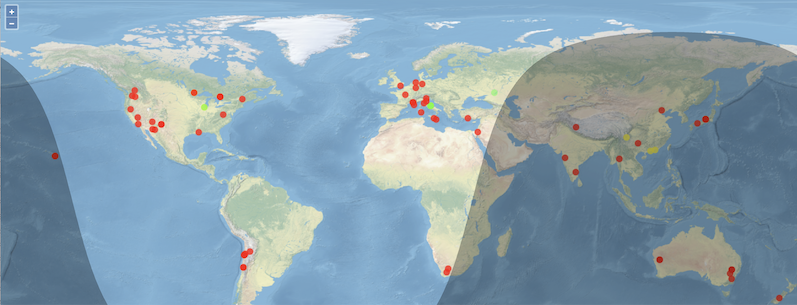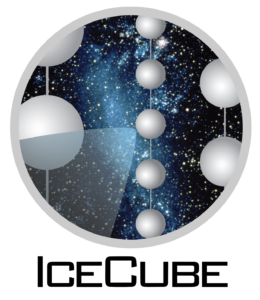The Supernova Early Warning System
When a massive star collapses at the end of its life, most of its binding energy is emitted in the form of neutrinos. These neutrinos emerge promptly from the stellar envelope over a timescale of tens of seconds. If the star later explodes, the burst of supernova photons does not become visible until hours later. We therefore expect to observe the neutrino burst from a Galactic supernova before we can see the optical counterpart in the sky. Although a Galactic supernova is rare and expected only every few decades, the next event will provide a unique opportunity to study these violent astrophysical phenomena.
The observation of a neutrino burst can thus provide a warning for astronomers that the opportunity to get a rare glimpse at the collapse of a star, resulting in a supernova, may soon be presenting itself. In addition, there is a real chance that a Galactic supernova may be observable with the naked eye, making this alert interesting to hobby astronomers and the general public alike. Most large-scale neutrino detectors around the globe thus joined forces in the SNEWS network to provide a high-sensitivity alert to interested parties. In addition, gravitational wave detectors like LIGO and Virgo have sensitivity to asymmetrically-collapsing supernovae and can both benefit from and contribute to such an alert.
The early supernova alert project has a central computer which accepts neutrino burst candidate messages from neutrino detectors around the world and sends an alert to astronomers if it finds a coincidence within a few seconds.
Research of the SNEWS collaboration is ongoing in a number of areas. We are improving the capabilities to accurately model supernova neutrino signals and triangulate the direction of the exploding star, and establishing optimized follow-up strategies to maximize the observational and scientific return. Here’s a fun interactive illustration of the how timing could help locate where the neutrinos are coming from.
For more information, please refer to this white paper describing SNEWS2.0.
Experiments Participating in the SNEWS network
SNEWS is a network which compares information sent to it from different experiments capable of seeing neutrinos from the collapse of a massive star at the end of its life. The experiments themselves do all of the actual neutrino detection: SNEWS provides a path to alert the world in event that multiple neutrino experiments around the world all see something interesting at the same time: which could be a supernova!
Although a supernova dumps 99% of its energy into 1058 neutrinos, these neutral particles interact so weakly that even these very large experiments will only notice any if that supernova happens somewhere in our own Milky Way galaxy: something that only happens once or twice a century.
Below is a partial listing of neutrino facilities that participate in SNEWS, along with information about how they work and what their day-to-day science activities include.
HALO
The Helium and Lead Observatory (HALO) looks for supernova neutrinos interacting with 79 tonnes of lead, which would produce neutrons detected by 128 3He “NCD” tubes borrowed from the SNO experiment. It is 2km underground in SNOLAB near Sudbury, Ontario.
NOvA
The NuMI Off-Axis Neutrino Experiment (NOvA) is a long-baseline neutrino oscillation experiment that observes the NuMI neutrino beam first at Fermilab with a 300kt near detector 100m underground then 810km later in Ash River, MN with a 14kt far detector on the surface in Ash River, MN. The liquid scintillator in each detector can see positrons from the interaction of supernova neutrinos within each detector. While waiting for a supernova, you can watch cosmic rays and beam neutrinos in NOvA.
JUNO
The Jiangmen Underground Neutrino Observatory (JUNO) is a multi-purpose neutrino experiment that will primarly detect reactor neutrinos at 53 km distance. It is under construction in China, located 700 m underground. With its large volume of liquid scintillator (20kton), it will be sensitive to all neutrino flavors from a core-collapse supernova. It will be a next-generation low-background supernova detector, able to provide the largest sample of neutral current interactions (~1000 proton elastic scattering events at 10 kpc above ~150 keV) from a CCSN. Its large statistics and good time and energy resolution are key for JUNO capabilities to perform CCSN physics. The commissioning of the experiment and the start of data taking will happen in 2025.
KamLAND
KamLAND (Kamioka Liquid Scintillator Antineutrino Detector) is a kiloton scale detector designed to measure Japan’s reactor anti-neutrinos but can also detect solar and geo-neutrinos. KamLAND has made precision measurements of neutrino oscillation parameters and now also searches for neutrino-less-double-beta-decay in the KamLAND-Zen experiment.
SNO+
The SNO+experiment is located 2.1km underground at SNOLAB near Sudbury, Ontario, making it one of the deepest neutrino detectors in the world. It consists of 780T of organic liquid scintillator surrounded by 2kT of ultra-pure water, itself surrounded by some 9300 photomultiplier tubes. Its main goal is to observe neutrinoless double-beta decay of the 130Te nucelus, but it is also an excellent detector of pre-supernova electron anti-neutrinos, and supernova neutrinos via inverse beta decay, neutrino-carbon interactions, and neutrino-proton elastic scattering.
DarkSide
DarkSide-20k is a dark matter direct detection experiment employing a 50 ton low radioactivity liquid argon target and designed to operate with zero backgrounds in a 10 year run, meaning that all sources of instrumental backgrounds are reduced to level much below the irreducible neutrino nuclear coherent scattering from atmospheric neutrinos. Thanks to the ionization signal detected in the gaseous Argon the experiment is also sensitive to nuclear recoils in the sub-keV range. This outstanding sensitivity to coherent nuclear recoils will enable DarkSide-20k to detect a supernova neutrino burst coming from anywhere in the Milky Way Galaxy and, for a majority of the galaxy, clearly identify the neutronization burst, thus performing a flavor-blind measurement of the total neutrino flux and average energy.
XENONnT
The newest member of the XENON family is XENONnT, employing a total of 8.6 tonnes of xenon. The infrastructure as well as subsystems of XENON1T were re-used, allowing for a fast upgrade by changing the heart of the detector system: the TPC with a new cryostat.
The XENONnT TPC has a diameter of 134 cm, a height of 148 cm, and encloses 5.9 tonnes of liquid xenon. A total of 494 3-inch photomultiplier tubes are distributed with 253 in the top array and 241 in the bottom one to measure interaction signals.
The water tank has been upgraded with gadolinium-loaded water. In addition to the Cherenkov muon veto, there is now a neutron veto volume around the cryostat optically separated from the surrounding muon veto. Signals coincident in the TPC and nVeto allows for a further reduction of neutrons that could potentially mimic a dark matter signature. Two new subsystems for the xenon purification during the detector operation have also been installed, namely a liquid xenon purification system and a radon distillation column.
The XENONnT experiment started data taking in 2020. Extensive simulations project that the sensitivity to spin-independent interactions after five-years with a 4 tonne fiducial volume is 1.4 × 10-48 cm2 for a 50 GeV/c2 WIMP.
IceCube
The IceCube Neutrino Observatory is a cubic-kilometer detector buried 1.5 km to 2.5 km in the deep Antarctic ice beneath the South Pole. Its 5,160 Digital Optical Modules (DOMs) can detect the Cherenkov light produced during the inverse beta decay of electron antineutrinos from a nearby supernova. While the IceCube DOMs are widely spaced and individually only detect single photons from each supernova neutrino that interacts in the ice, collectively the entire detector will observe more than one million photons from a supernova at 10 kpc, providing detailed measurements of the neutrino burst with sub-microsecond resolution. The full detector has operated with >99% uptime since 2011 and is the world’s premier monitor for supernova neutrino bursts near the Milky Way.
This table shows the estimated interaction rates for neutrino detectors using models of supernova explosions at a distance of 10 kpc. The models for 11.2 M$_{\odot}$ and 27 M$_{\odot}$ progenitor stars form neutron stars and are from Mirizzi et al. 2016. The model for 40 M$_{\odot}$ forms a black hole and is from O’Connor (2015). The two numbers given are the total events over all channels using SNOwGLoBES assuming adiabatic MSW oscillations only for the normal mass ordering (left number) and the inverted mass order (right number). The masses for long-string water Cherenkov detectors are “effective masses” that measure the target mass weighted by the incoming spectra, to allow better comparisons between the contained fiducial volumes elsewhere in the table and these open detectors. This table has been updated from the SNEWS2.0 paper, using the current version of snewpy.
$\begin{array} {|r|c|r|c|c|c|c|}\hline \text{Experiment} & \text{Type} & \text{Mass [kt]} & \text{Location} & \text{11.2 M$_\odot$} & \text{27.0 M$_\odot$} & \text{40.0 M$_\odot$}\\ \hline \text{Super-K} & \text{H$_2$O$/\bar{\nu}_e$} & 32 & \text{Japan} & 4100/4100 & 7800/7600 & 7600/4900\\ \hline \text{Hyper-K} & \text{H$_2$O$/\bar{\nu}_e$} & 220 & \text{Japan} & 28\text{K}/28\text{K} & 54\text{K}/52\text{K} & 52\text{K}/34\text{K}\\ \hline \text{IceCube} & \text{String}/\bar{\nu}_e & ~2500* & \text{South Pole} & 320\text{K}/340\text{K} & 670\text{K}/660\text{K} & 820\text{K}/630\text{K}\\ \hline \text{KM3NeT} & \text{String}/\bar{\nu}_e & ~150* & \text{Italy} & 18\text{K}/19\text{K} & 39\text{K}/40\text{K} & 55\text{K}/46\text{K}\\ \hline \text{LVD} & \text{C$_n$H$_{2n}/\bar{\nu}_e$} & 1 & \text{Italy} & 190/190 & 360/350 & 340/230\\ \hline \text{KamLAND} & \text{C$_n$H$_{2n}/\bar{\nu}_e$} & 1 & \text{Japan} & 190/190 & 360/350 & 340/230\\ \hline \text{Borexino} & \text{C$_n$H$_{2n}/\bar{\nu}_e$} & 0.278 & \text{Italy} & 52/52 & 100/97 & 95/65\\ \hline \text{JUNO} & \text{C$_n$H$_{2n}/\bar{\nu}_e$} & 20 & \text{China} & 3800/3800 & 7200/7000 & 6900/4700\\ \hline \text{SNO+} & \text{C$_n$H$_{2n}/\bar{\nu}_e$} & 0.78 & \text{Canada} & 150/150 & 280/270 & 270/180\\ \hline \text{NO${\nu}$A} & \text{C$_n$H$_{2n}/\bar{\nu}_e$} & 14 & \text{USA} & 1900/2000 & 3700/3600 & 3600/2400\\ \hline \text{Baksan} & \text{C$_n$H$_{2n}/\bar{\nu}_e$} & 0.24 & \text{Russia} & 45/45 & 86/84 & 82/56\\ \hline \text{HALO} & \text{Lead/$\nu_e$} & 0.079 & \text{Canada} & 4/3 & 9/8 & 9/9\\ \hline \text{HALO-1kT} & \text{Lead/$\nu_e$} & 1 & \text{Italy} & 53/47 & 120/100 & 120/120\\ \hline \text{DUNE} & \text{Ar/$\nu_e$} & 40 & \text{USA} & 2700/2500 & 5500/5200 & 5800/6000\\ \hline \text{MicroBooNe} & \text{Ar/$\nu_e$} & 0.09 & \text{USA} & 6/5 & 12/11 & 13/13\\ \hline \text{SBND} & \text{Ar/$\nu_e$} & 0.12 & \text{USA} & 8/7 & 16/15 & 17/18\\ \hline \text{DarkSide-20k} & \text{Ar/any $\nu$} & 0.0386 & \text{Italy} & 120/120 & 200/200 & 110/110\\ \hline \text{XENONnT} & \text{Xe/any $\nu$} & 0.006 & \text{Italy} & 39/39 & 69/69 & 44/44\\ \hline \text{LZ} & \text{Xe/any $\nu$} & 0.007 & \text{USA} & 33/33 & 61/61 & 42/42\\ \hline \text{PandaX-4T} & \text{Xe/any $\nu$} & 0.004 & \text{China} & 26/26 & 46/46 & 29/29\\ \hline \end{array}$









